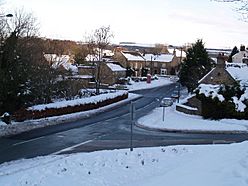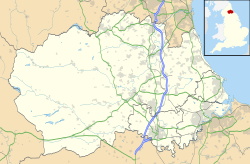Vindomora facts for kids
Quick facts for kids Vindomora |
|
|---|---|

Modern village of Ebchester, and approximate site of Vindomora
|
|
| Known also as | Ebchester Roman Fort |
| Place in the Roman world | |
| Province | Britannia |
| Stationed military units | |
| — Cohorts — | |
| IV Breucorum | |
| Location | |
| Coordinates | 54°53′38″N 1°50′19″W / 54.8940°N 1.8385°W |
| Place name | Ebchester |
| County | County Durham |
| Country | England |
| Reference | |
| UK-OSNG reference | NZ103555 |
Vindomora was an ancient Roman fort. It was part of the Roman province called Lower Britain. Today, its ruins are known as the Ebchester Roman Fort. You can find them in the village of Ebchester in County Durham, England. This site is about 12 miles west-south-west of Newcastle upon Tyne.
Contents
Discovering Vindomora's Past
Vindomora was an important Roman fort located along Dere Street. This was a major Roman road connecting Eboracum (modern York) to Hadrian's Wall. The fort was built between other forts like Corstopitum (Corbridge) to the north and Longovicium (Lanchester) to the south. It also helped protect the River Derwent.
What Does the Name Vindomora Mean?
The name Vindomora comes from an ancient British language. The first part, windo- (or vindo-), means "fair" or "white." The second part, māra, means "great" or "big." So, the name likely meant something like "Great White Place." Some people mistakenly thought it meant "The edge of the Black Moor" or "End of the Hill."
After the Romans left, the area became known as "Ebchester." This name means "The Camp on the Height." The main road through the village today is still called Vindomora Road. The fort is only mentioned in an old Roman travel guide called the Antonine Itinerary.
What Remains of the Fort Today?
Not much of the fort is clearly visible now. This is because the modern village of Ebchester was built right on top of it. Unlike many other Roman sites, the new town didn't move away from the old fort.
In Ebchester, you can find parts of the Roman fort mixed in with gardens, houses, roads, and even St. Ebba's Church. Some parts of the fort's outer wall, called the rampart, can still be seen near the post office. Archaeologists have also found building stones and small altars. These finds have helped them figure out which Roman army units were stationed there.
Roman Roads Connected to Vindomora
Historians believe there might have been a road from Vindomora to another Roman fort called Washing Wells Roman Fort in Whickham. However, this road has not yet been found. Recent discoveries also suggest that Dere Street might have continued to Bywell, not just to Corstopitum (Corbridge) as once thought.
Another road left Vindomora heading northwest towards Whittonstall. From there, it might have gone to Corbridge or even Hexham, which may have had its own fort. Other finds near Concangis (Chester-le-Street) suggest that Vindomora was also connected to that fort by a road and a bridge.
Gods Worshipped at Vindomora
The Roman soldiers at Vindomora worshipped a mix of gods. These included traditional Roman gods and also local Germanic and Celtic gods. For example, two altars found there mention an ancient Germanic ancestor-god named Vitiris. Another altar was dedicated to a genius loci, which means a "spirit of the place" or a local guardian spirit.
Roman war gods like Mars and Minerva were also worshipped. There was even a god named Vernostonus Cocidius, who seemed to be a combination of two Germanic war gods.
Who Guarded Vindomora?
When the fort was first built, it was constructed by highly skilled Roman legionaries. These were the main soldiers of the Roman army. They built all auxiliary forts, even though other types of soldiers would live in them later. Building stones found at Vindomora show that a "Fifth Cohort" built the fort. These stones also name the Centurions (army officers) who were in charge of the construction.
Later, auxiliary regiments (soldiers who were not full Roman citizens) did repair work. This happened during the time of Emperor Severus when he led campaigns in Scotland.
The Fourth Cohort of the Breuci
The first unit known to have lived at Ebchester was the Cohors Quartae Breucorum Antoninianae. This means "The Fourth Cohort of the Breuci: Antonine's Own." This unit was an Auxilia unit, meaning it was made up of soldiers from other parts of the Roman Empire, not full Roman citizens.
They were an infantry (foot soldier) regiment, usually with about 500 soldiers, though often closer to 460. These soldiers originally came from the Breuci tribe, who lived in the Bosna valley in what is now Bosnia-Herzegovina. This unit might have also been stationed at Lavatris (Bowes), but the writing there is too damaged to be sure.


